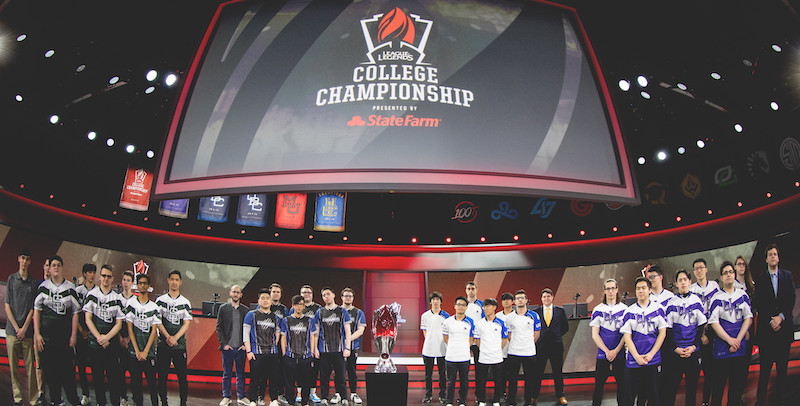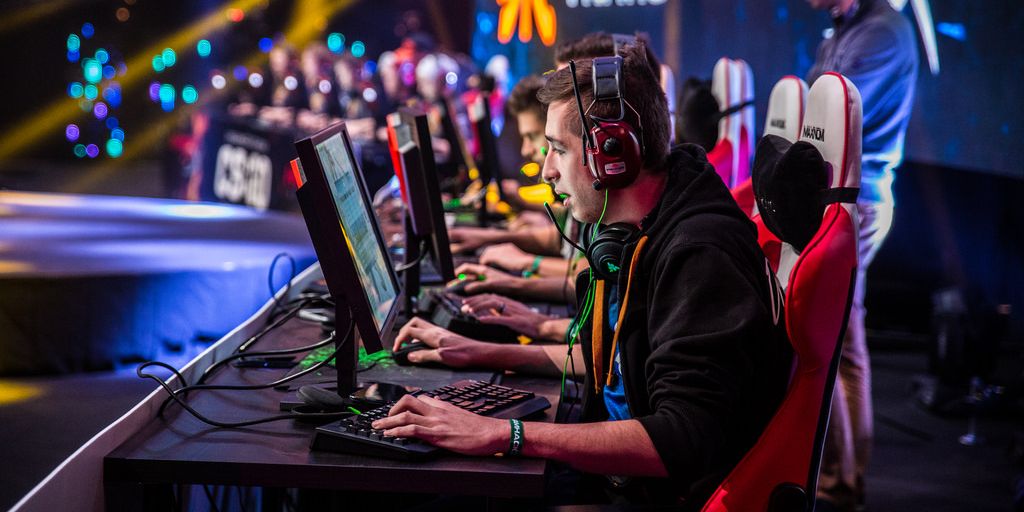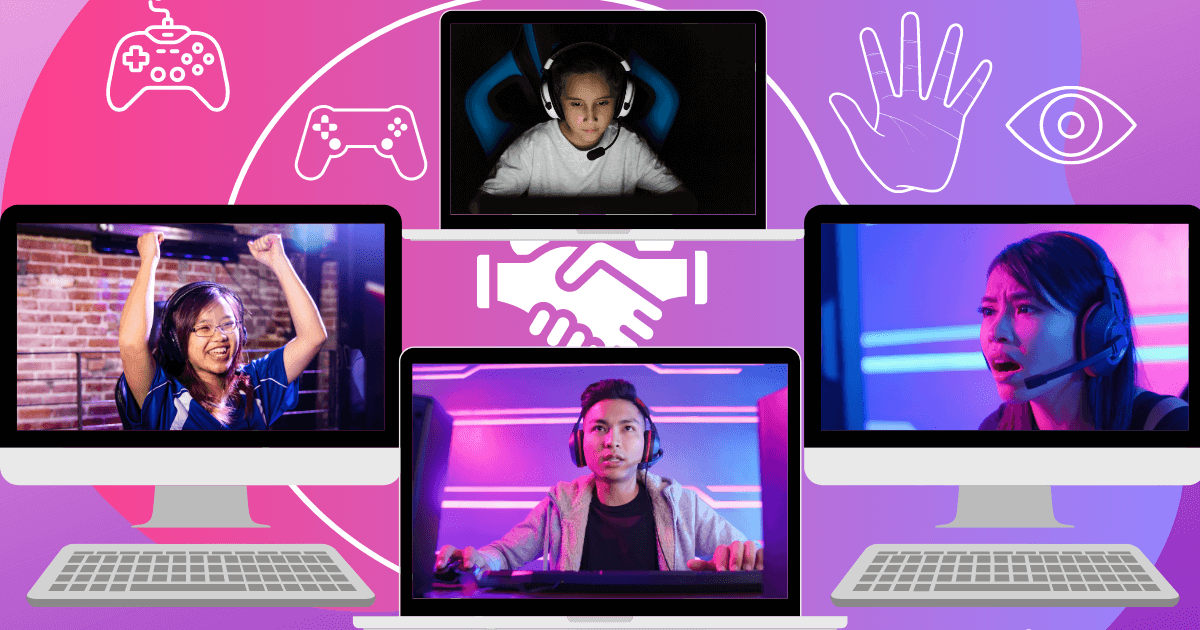Back in 2020, we published a white paper on esports in education. If you’ve heard the term mentioned or maybe done some research on launching a program at your school, we’d definitely suggest giving it a read. Esports opportunities in high school, middle school, and even up at the college level can wind up providing students with very worthwhile experiences, including on both the social and academic sides of things. And, since it's become a varsity sport within numerous high schools, students get to harness their interests and skills in team-centered competition. It could also help them find their place within school communities and potentially even earn college scholarships. This week, we’re looking at some of the ways in which esports can benefit those who participate.
Enhancing the School Community with Esports
We all know that millions of students participate in interscholastic high school sports every year. For others, however, they believe they're not good enough, don’t enjoy this competition, or believe it’s not a place they belong. This could lead to social isolation as these students often feel that they wouldn't fit into the athletic world. But, like so many other kids, they usually do have other things they are passionate about and, more and more frequently, their passions include video games. Some of the most committed gamers these days are in high school and college. They spend so much of their time perfecting their craft, working on strategy, and taking part in informal competitions. So, esports leagues simply provide an avenue for formalizing that competition and extending the camaraderie students build.
Boosting community among esports athletes.
In a school setting, it just takes a few interested students for starting an esports program. With the help of a coach who understands the gaming world, you can start building up this community. The games esports athletes play often require a great amount of collaboration. Players are constantly coming together to share strategies—both during official team practice times and outside of those times. Learning to work with their teammates—exactly like in traditional team sports—often translates to success for any esports team. And, this begins with feeling like they belong and feeling comfortable with voicing their opinions as well as with holding others accountable. With this sense of community, student gamers can experience collaboration, strategizing, and leadership while doing something they’re passionate about.
High school esports and collaboration.
In the white paper, we included quotes from three educators who became involved in high school esports during recent years. The most consistent benefit they touted for students who participate in interscholastic esports is the collaborative aspect of the sport. That collaboration, however, isn't limited to their own team. We learned a lot about how students from different schools and different teams (i.e. opponents) routinely speak to each other before or after the matches to compliment each other’s performance when it comes to specific achievements and even offer advice or talk strategy. By bringing together students who share this common interest, especially those who aren't involved in other school clubs or activities, esports can help build up or extend the feeling of community in schools. This became even more pertinent in today’s world since students could continue playing remotely when necessary.
Connecting Students Through Esports
Being part of a team—in this case esports—can help students create long-lasting and deeper connections with their peers. Whether in informal gaming or sanctioned competitions, they could learn to build a culture and stay connected thanks to technology. We’ve said so before but esports was the only school sport that continued when the pandemic crept into our lives. Students were able to stay connected, continue playing together, and strategize remotely—almost without missing a beat. Without having to pause these activities, esports athletes also maintained connections with teammates since the communication is so constant and so clear that it’s almost like they were physically together anyway, which is still one of the biggest benefits of esports in schools. For this reason and others, these connections can truly be transformative.
Forming bonds using esports in high schools.
Esports coaches and school officials often focus on their esports environment and their tech infrastructure. With that physical environment in place, your social environment often starts to take shape as well. It might seem kind of insensitive but, when students have some higher end technology with which to game, they'll tend to get a lot more excited and can even work together more effectively. When coaches begin designing a program or a meeting space, it’s helpful to think about esports as more than a STEAM activity, more than using cool equipment, more than winning competitions, and not the solution to drown out some unwanted noise surrounding the cons of esports in schools. Students can bolster some truly useful real-world skills for building connections, including those related to SEL development.
Benefits for all students in the school community.
Another way that esports helps students create connections amongst each other is through the culture that coaches create. Especially in high schools, athletic culture is often perceived in certain ways, which can be why some students don't get involved in traditional sports. In starting up an esports program, students and coaches have new opportunities to redefine school athletic culture and rebrand it as something that’s more inclusive and welcoming—even across genders. These opportunities to value diversity have even bolstered participation and helped students create new connections to college or future careers. Finally, students can start making connections between being a part of a team and overall social-emotional health as a result.

Earning College Esports Scholarships
Though fairly uncommon and definitely more of a long-term benefit, students who participate in esports can possibly earn college scholarships. Since esports is an interscholastic sport just like soccer, football, or softball, it is part of competition among high school athletes. Just as it is popular with students at this level, it also remains popular among students as they enter college, leading to the emergence of esports programs at universities. As time has passed, college esports programs have evolved in the same ways as high school programs. They tend to start on the smaller side and, in some cases, they might grow into powerhouses. Then, they may launch formal leagues and many college teams have participated officially for a few years, leading to the availability esports scholarships.
Scholarships for student gamers.
In the grand scheme of things, it’s a small percentage of colleges that have formal and competitive esports programs. And, to be honest, it’s a small percentage of those schools where students can earn scholarship money. Though possible, we wouldn’t necessarily encourage student-athletes to rely on receiving a college scholarship to play esports. Even with this chance, many available esports scholarships are at schools on the west coast and, on average, cover only a few thousand dollars per year. In our conversations, however, we did hear of one student who received a full ride to play esports at a college in California, so it definitely is possible. Of course, even a small chunk of scholarship money can be super helpful to most students. It also provides something to work towards as they begin navigating the next phase of their education.
Availability increases with popularity.
Esports scholarships are becoming more common as more esports programs emerge at the college level. While they may or may not feel competitive right away, some college coaches try recruiting talent from the outset. Since there's a small number of esports scholarships available, prospective students need to know where to look. It might be tough to find information about esports scholarships on college websites even if they have an esports program. Students who do receive a scholarship, however, go through their daily lives like all other student-athletes. They go to class, pick a major, and then need to show up for team practices, meetings, or matches. The most common type is partial scholarships, but they could also have a full tuition scholarship (no other expenses covered) or full-ride scholarships with all their expenses covered. So, we’re saying there’s a chance.
Exposure to Potential Careers in and out of Esports
Yes, there's a chance students who play esports in high school could play in college or maybe become professional gamers. We’ve seen people make a pretty decent living off their tournament profits as well as sponsorships since this international interest in esports drives tons of revenue as fans attend the matches, purchase merchandise, and stream live events. While in-person spectating has evolved with the pandemic, that doesn’t mean that the competitions ever stopped. For students, they are always able to meet virtually and go over strategy like they would during practices. Also, they've been known to organize matches with teams from other schools in the offseason but, more importantly, they can practice virtual communication, which, as we’ve seen, could remain a huge part of the workforce.
Benefits for those students who aren't playing.
The thing with high school esports is that there aren't enough “starting” spots for everyone to play in every match. Typically, there are six players who participate in the meet. If there's a JV team, that could bring the total to 12 meaning that the top-12 players are who compete. In many cases, however, there are a lot more students than that, so, rather than sitting off to the side, those who are not participating in actual gameplay often do other things for the teams. Depending on how long the school program has been active and what interests the alternate players have, there's something relevant to the team and the esports world that they can explore. Plus, many of the jobs provide previews for future careers within the esports industry or not.
Potential jobs within esports.
Some potential careers include team management, website design, marketing and promotion, social media management, and even game designing. For example, students may need to find a place for practices and matches, design the layout of the space, order uniforms, make a schedule, and handle other logistics. This is an opportunity to learn the skills and techniques associated with management jobs. Also, they may need someone to manage a website to amplify exposure throughout the school community or the esports world. Websites could include images, videos, team information, upcoming events, or links to live streams for the matches. From there, they can promote that content and that’s how a marketing specialist comes in. They could promote their team on social media, with email blasts, blogs, live streams, or on the school website. Those are just some of the ways in which getting involved in esports can impact a student’s future.

New Academic and Social Experiences
It’s always good to try new things, right? Well, in playing esports as part of a team, children could do just that. For many, perhaps they’ve grown up playing video games mostly alone, occasionally playing with or against a friend or sibling. Maybe as they’ve gotten older, they’ve even tried competing against strangers online to help create a new challenge. While these are both common in the gaming world, participating in organized esports creates new experiences—even for seasoned gamers. For example, we mentioned the teamwork aspect with esports. This could be brand-new to many student gamers, especially if they have spent their childhoods playing independently. Discovering how to play as a team might involve a learning curve but also a chance to explore something new.
The most commonly played games.
It could also be exciting to learn about new games and strategies for succeeding in those games from their teammates. Various students might be used to playing games that fall outside of what the common games are for esports competitions. For example, among the most popular games you’ll find students competing in are League of Legends, Overwatch, and Rocket League. Some kids may not have necessarily grown up playing those games, however, and perhaps were more into the sports games, like Madden or NBA 2K, or racing games, like Gran Torino. While those three that we mentioned are among the most popular, it’s also possible—especially in more informal school esports clubs—for students to be playing other games too, like Fortnite, Super Smash Bros., and even Minecraft.
Boosting pride through esports involvement.
Finally, another new experience is the chance to play with some powerful equipment in a dedicated space. It’s not true in every high school but, as students move on to college, they may have nicer esports facilities. Some high schools do, in fact, have beautiful facilities set up for esports programming and seeing that their administrators care about their interests and their futures goes a long way with these kids. And, having new equipment to use, like gaming headphones, keyboards, and mice, can be a thrilling experience for them. Also, seeing game action projected on a big screen can boost that pride even more. So, yes, despite being incredibly young, esports can help create a slew of benefits among high school students, college students, teachers, coaches, and administrators as long as they make a commitment.
If you're interested in learning about esports in high school or college, we encourage you to download our white paper. In it, we cover various strategies and share advice for launching a program with insights from coaches who've done it. For the latest EdTech, STEM, and 21st century education news, follow Eduporium on Twitter and Instagram, like us on Facebook, or sign up for our newsletter for all of our updates.






